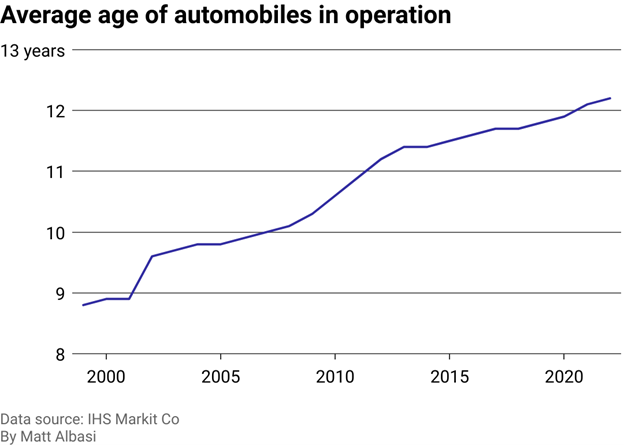Logical advances to our long relationship with the vehicles. Suspensions are more rugged today, while engines are more fuel efficient and last longer than ever before: reaching 200,000 miles on your odometer without major problems. Unheard of anymore. But since 2017, manufacturers have been producing fewer models each year, which has also increased the cost of new vehicles.
In 2018, the auto industry saw a shift from the US market being saturated with new vehicles. Auto sales fell due to the Great Depression, but emerging Americans took advantage of the low interest rates set by the Federal Reserve to take out loans. Due to this, new car sales have increased.
An owner of an older vehicle will incur higher maintenance costs as more miles are put on the odometer. But eventually, the car loan is paid off and maintenance, insurance and fuel are the main costs of owning a vehicle. As a car generally loses value as it ages, an older vehicle can also be cheaper to insure than a new car. These factors can make keeping a paid-off, aging vehicle—rather than trading it in for a new ride—a solid proposition for everyday transportation these days.
Falling vehicle affordability since the start of the pandemic threatens to add another factor to extending vehicle ownership. Computer chip shortages and supply chain problems have set manufacturers already hit hard by the Covid-19 disruptions, with new and used vehicle prices set to see their biggest spikes in recent history in 2021. Rising demand and limited supply pushed prices out of reach for many prospective buyers.
Popular mainstream vehicles like the Toyota RAV4 and Honda CR-V, which were affordable until 2019, are now out of reach for the average consumer, according to a recent analysis by the used car search engine. iSeeCars.
The Average monthly car payment for a new vehicle It hit an all-time high of $648 earlier this year, according to Edmonds. While five-year auto loans are common, consumers typically sign six- and seven-year notes for new vehicles. Read on to learn more about how the length of car ownership has changed in the United States over the past few decades.
Quality car insurance coverage at affordable rates
General covers various types Motor vehicle insurance Coverage options including liability, collision, comprehensive and full coverage.
The vehicles have been on the road for over 12 years now
The average age of vehicles on American roads increased at the fastest clip on record at the start of the 21st century. It maintained a steady upward trend in the 2010s. The sudden increase in average ownership for vehicles is largely due to the financial crisis of 2008 and the Great Recession, when many American consumers held on to what they had and delayed major purchases.
Minimum liability insurance required
Most states require minimum liability auto insurance. Get hassle-free, guaranteed Liability insurance quote Online in 2 minutes.
The price of new automobiles has increased by more than 17% since 2020
Automobile prices have risen over the past 24 months as the average age of vehicles on US roads has steadily increased over the past five years.
When the COVID-19 pandemic began, many U.S. auto dealerships ground to a halt as nervous customers turned away and social distancing guidelines forced many to close temporarily. Dealership sales teams without strong online purchasing and distribution systems quickly hit the gas in streamlining online shopping and socially distanced delivery processes, as did emerging competitors like Carvana.
A line chart showing cars available for sale before the pandemic is rapidly declining.
As inventory has fallen since 2000, consumers have noticed a dwindling selection of new vehicles to choose from on dealership lots. Manufacturers saw inventories decline after the Great Recession began, but have steadily replenished inventories since the mid-2010s. Depressions.
Domestic Car inventory is very low Data collection began in 1993. Demand for new vehicles eased after 2018 but picked up again in 2021 as automakers struggled to deliver new units to dealerships.
Get cheap car insurance quotes fast
Get a free, secure one Car insurance quote Online in minutes. Hassle-free, no commitment.
A line chart showing that new passenger car registrations are also trending downward.
New vehicles on the road are a boon to the auto service industry, which gains a larger market of potential customers with every new Toyota Corolla and Ford Bronco. Inventory crunches on dealership lots starting in 2021 have led to higher prices, fewer new vehicle sales and fewer passenger cars being registered in every state.
Written by: Dom DeFurio
- FintechZoom PFE Stock – How Pfizer’s Positioning In The Market? - July 10, 2024
- FintechZoom Ford Stock With Performance and Future Projections - July 8, 2024
- Step-by-Step Guide: Integrating QWEFV into Your Business Systems - July 7, 2024

